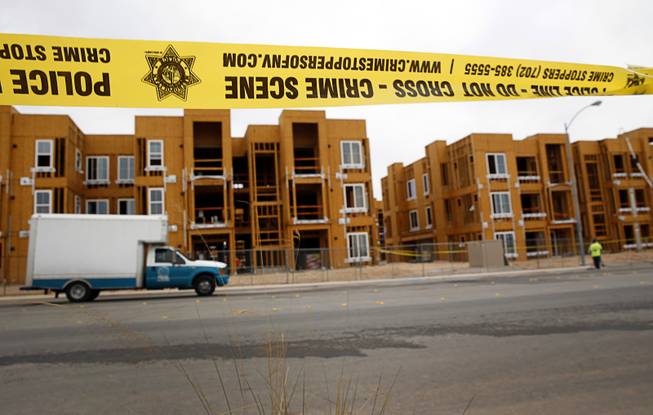
Police tape is shown near an apartment complex under construction Wednesday, April 27, 2016, at Jerry Tarkanian Way and Hacienda Avenue. A security guard was shot and killed at the site early Wednesday, police said.
Thursday, April 28, 2016 | 2 a.m.
Metro Police officers arrived at a southwest valley construction site early Wednesday to find the body of a security guard who had earlier been reported missing by his employer.
The man was shot several times, police said, and detectives were tasked with investigating Metro's 62nd homicide of the year — double the number investigated during the same time last year.
On Wednesday, Clark County Sheriff Joseph Lombardo addressed the surge in violent crimes and what his agency is doing to counter it.
Violent crime, which also includes sexual and aggravated assault and robbery, is up about 15 percent in Las Vegas, he said. It was up 5 percent from 2014 to 2015.
"I'm losing a lot of sleep over the issue," Lombardo said. "Now you know what keeps me up at night."
The most important thing I can do is provide a blanket of safety to this community, he said. "And that's what we're attempting to do, and we will do that, I guarantee, we will do that."
Increase in violent crimes is a nationwide problem, said Lombardo, who has consulted with the Los Angeles Police Department and the Los Angeles County Sheriff's Office, as well as with former Clark County sheriffs Doug Gillespie and Bill Young.
California authorities are facing similar issues, he said.
Gang ties
About 50 percent of the 62 homicides investigated by Metro this year are linked to gang activity, Lombardo said.
Lombardo responded to reports that suggested the possible rise in violence could be due to Metro's decentralizing of its gang unit.
"I have not gotten rid of the gang unit," he said. "I want everybody to understand that."
Instead, he said, the unit was split to cover different area commands, which have unique gangs. That way, officers focus on gathering intelligence and not just "driving around and hoping you encounter the right people."
He said decentralization, which was an approach mimicked from the LAPD, has been effective.
Prison depopulation
There's a "greater scale in violence across the nation" that is "directly related to depopulation of prisons across the nation," Lombardo said. That includes Nevada and California.
In California, Lombardo said, it can be traced to Assembly Bill 109, signed into law in 2011 and Proposition 47, which became law in 2014.
"A lot of the gang activity" seen is being done by nonviolent felons whose prison terms have been cut short by the California laws, Lombardo said.
Proposition 47 focused on allowing some nonviolent felony sentences, like drug possession and petty theft, to be reduced to misdemeanors.
Assembly Bill 109, also known as the California Public Safety Realignment Act, transferred some felons serving time for nonviolent, nonserious and nonsexual crimes, from state to county jails, according to the "Downsizing Prisons: Is Downsizing Prisons Dangerous?" research article published this year. There were also reductions to parole supervision and time served for violating parole.
The data from the research article, coauthored by UNLV criminal justice associate professor Emily Salisbury, was gathered from 2011 to 2014.
Salisbury said that linking the rise of crime in Southern Nevada to California depopulation is "highly speculative."
"I don't dispute the data they have," she said. But "based on our research, we have not found evidence that (depopulation) increases violent crime — at least in California."
Salisbury theorized that the rise in violent crime could be due to the availability and purity of heroin and the gangs that fight over control of the market.
Increased interactions with Californians
Over the years, Lombardo said, "We have seen individuals directly related to California committing crimes here in substantial numbers."
In recent times, there's about a 25 percent increase in interactions between Metro officers and Californians, some who have been penal residents, he said.
Younger offenders and weapons
Over time, the age of offenders has decreased, Lombardo said.
The majority of homicide suspects arrested this year are under 30, Lombardo said. There has also been an increase in weapons used in violent offenses.
A teenager was arrested Saturday in a melee in which four people were shot, one fatally, and one stabbed at a southeast valley recreation center. Angelo Barboza, 15, died inside a truck before first responders arrived.
"(It's) extremely unacceptable that those parents in the parental function of our society do not know where their kid is," Lombardo said. "Fourteen to 15 years of age at 3 o'clock in the morning in the possession of a weapon."
Lombardo said he met with Clark County District Attorney Steven Wolfson, who vowed that his department would adequately prosecute and "put eyes on any case associated with violent felonies and participation with a firearm."
Violent-crime initiative
Metro's violent-crime initiative, which pulled detectives from across the department earlier this year and made them patrol and gather intelligence, has offered "short-term" success, Lombardo said.
The strategy permanently puts officers from all departments, including SWAT and internal affairs, in rotation to saturate areas of concern based on intelligence, Lombardo said.
Though homicides are up, Lombardo said, the department has made some progress.
Police presence
Ideally, Lombardo, wants Las Vegas to have as many officers as the national average, which is 2.2 officers for every 1,000 residents. "Currently the economic climate will not let me achieve that number."
Metro will maintain its 1.8 officers per every 1,000 residents in 2017, he said.
Solvability
Metro's homicide unit solves about 80 percent of the cases it investigates, Lombardo said. That's above the national average that sits at 60 to 65 percent.
"Remember, that's after the fact," he said. "I do not want a homicide to occur."
Decentralization has also helped Metro officers investigate different cases in a more timely manner, which wasn't the case before.
Too early to tell
A rise in violence is "always cause for concern," said William Sousa, UNLV associate professor and director of the Center for Crime and Justice Policy.
However, a few months or years are not considered a very long time to indicate a longer-term trend, he said.
Homicides are difficult to predict, which make them difficult to prevent, he said.
"Overall, we're in a period of general decline," he said, which doesn't mean police and residents shouldn't be concerned about it.
Lombardo said the department is doing everything it possibly can to ensure the community's safety.
About his officers and captains, he said: "I hope they are feeling the pressure."


Join the Discussion:
Check this out for a full explanation of our conversion to the LiveFyre commenting system and instructions on how to sign up for an account.
Full comments policy